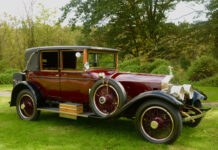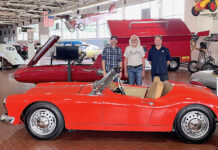By Jay Hirsch
Packard was founded by James Ward Packard, a mechanical engineer, along with his brother, William, and George Lewis Weiss in Warren, Ohio, in 1899. Weiss also owned stock in the Winton car company. James Packard owned a 1898 Winton and believed the Winton could be improved upon. He brought the car to Alexander Winton and made some suggestion as to how to improve the Winton. Alexander told James if he was so smart to go ahead and build his own car. Out of this rejection by Winton, the Ohio Automobile Company was founded to make Packard automobiles.
Packard soon gained a reputation for being an excellent car. One of those owners of a Packard was Henry Joy from Detroit. Joy’s family was one of the oldest and wealthiest in Detroit. Henry was so impressed with the Packard’s reliability that he visited James and William. Henry then put together a group of investors and on Oct. 2, 1902, the group bought the Ohio and New York Automobile Company and changed the name to the Packard Motor Car Company, with James Packard as president. Packard soon changed their operations to Detroit and Henry Joy was the general manager. He eventually became the chairman of the board.
“Ask the man who owns one,” was a Packard advertising slogan from 1902 until the last real Packard was made in 1956. It supposedly came about when “someone” asked Henry Joy how good a car the Packard was. Henry’s reply was, “Ask the man who owns one!” (Women did not vote in 1902 let alone buy a car. It was not until 1920 that women got the right to vote in the U.S.)
There is another telling of the slogan that goes this way: James Packard is in his office, and his secretary says: “Here’s a letter from a man who wants information about the dependability of Packard cars.” To which James Packard replies, “Since we have no sales literature yet, tell him to just “ASK THE MAN WHO OWNS ONE!”
By 1910 Packard was recognized as one of the great cars being made, whether in the United States or Europe. In the 1930s the official car for the Emperor of Japan was a Packard V-12 Victoria four-door convertible.
With the stock market crash of 1929 and the subsequent Depression in the early 1930s, cars and luxury cars in particular took quite a hit in the United States,
The 1930s saw the demise of several car companies in the country, but Packard managed to survive by bringing out a smaller and less expensive Packard, the “120.” At the height of the Depression, many wealthy people who still had money did not drive their luxury cars but kept the car in a garage, as it was considered to be in bad taste to be seen driving around in such a luxury car, and at times dangerous.
By 1935 the economy was slowly on the rebound and in 1936 to own a car like the V-12 Packard Dietrich was acceptable. The few people who owned a Dietrich Victoria used it to go to the country club, the yacht club or to a downtown department store.
The car seen here not only has undergone a full restoration but also some major refabrication. Sal, the owner of the car, is a “car guy,” and an admirer of Packards in particular. Sal also owns a 1941 Packard with factory air conditioning. Packard was the first car to have factory air conditioning, and it was in 1941.
 When Sal bought this 1936 V-12 it was a “basket case.” Not only was the interior destroyed, but the frame for the convertible top was long gone. Thus began a 12-year search for correct parts and to find some one capable of making the correct bows for the convertible top and then making the correct top for those bows. In addition to rebuilding the engine, transmission and all mechanical components, there was the question of what color to paint the car and the color for the interior. As the Packard was a custom-bodied Dietrich, the color could have been any color available in 1936. After removing layers of paint of various colors, the last color before the bare metal, the color the car was painted when new was similar to the green the car is now. Sal was not as concerned with having the car the original color as to finding out what it was. He was leaning towards a creamy yellow color that was popular in 1936, but when he saw the green, he and his wife “fell in love with that color.” The green on the car now is a late 1990s Jaguar green, which is almost the same as the original green. Next was the color choice for the leather interior. Sal was thinking of tan or saddle colored leather, and Joann thought a “creamy beige” would be better suited to the green paint, and “she was right,” Sal said. In researching the canvas top with George Dragone from Dragone Classic Cars in Westport, Conn., George pointed out that besides the traditional tan or black canvas seen on many 1930s cars, Packad also used some canvas tops in lighter shades of the paint used on the body of the car. So the color of the top is “not a reflection of the paint,” but a subtle shade of a very light green.
When Sal bought this 1936 V-12 it was a “basket case.” Not only was the interior destroyed, but the frame for the convertible top was long gone. Thus began a 12-year search for correct parts and to find some one capable of making the correct bows for the convertible top and then making the correct top for those bows. In addition to rebuilding the engine, transmission and all mechanical components, there was the question of what color to paint the car and the color for the interior. As the Packard was a custom-bodied Dietrich, the color could have been any color available in 1936. After removing layers of paint of various colors, the last color before the bare metal, the color the car was painted when new was similar to the green the car is now. Sal was not as concerned with having the car the original color as to finding out what it was. He was leaning towards a creamy yellow color that was popular in 1936, but when he saw the green, he and his wife “fell in love with that color.” The green on the car now is a late 1990s Jaguar green, which is almost the same as the original green. Next was the color choice for the leather interior. Sal was thinking of tan or saddle colored leather, and Joann thought a “creamy beige” would be better suited to the green paint, and “she was right,” Sal said. In researching the canvas top with George Dragone from Dragone Classic Cars in Westport, Conn., George pointed out that besides the traditional tan or black canvas seen on many 1930s cars, Packad also used some canvas tops in lighter shades of the paint used on the body of the car. So the color of the top is “not a reflection of the paint,” but a subtle shade of a very light green.
As for “how does the car ride” question, with a 139-inch wheelbase and three tons of iron, on the interstate or any smooth road the ride is superb. As for “handling,” the car is 6,000 pounds with no power steering. Handling was not a thought in 1936; it was all about the ride and comfort. No one bought a 1936 Packard V-12 Victoria for handling, and no one owns on of the few that remain for today for handling.
At the AACA fall 2015 Hershey meet, Joann and Sal’s Packard took a first junior in its class and was also nominated for an AACA National award.
As for the Dietrich body, Ray Dietrich was born in the Bronx, N.Y., and was an independent car designer and custom coachbuilder. In the late 1920s he worked with the Fred Murray Custom Auto Body Company. Many of Dietrich’s custom bodied cars were convertibles. His convertible Victoria sat four passengers inside, with the passengers in the rear having center-folding and side armrests. When the rear passengers were not carried, this space accommodated golf clubs or luggage. The 1930s was a time when a two-door convertible only had a front seat. If there were two-extra passengers they sat in the rumble seat, exposed to wind and the weather
In 1930 there was a falling out between Fred Murray and Ray Dietrich and Ray was forced to resign. Murray retained the design and the name Dietrich Custom body Victoria. In 1936 when Packard went forward with this magnificent automobile even though Ray Dietrich was no longer with Murray Auto his name and design was. •



